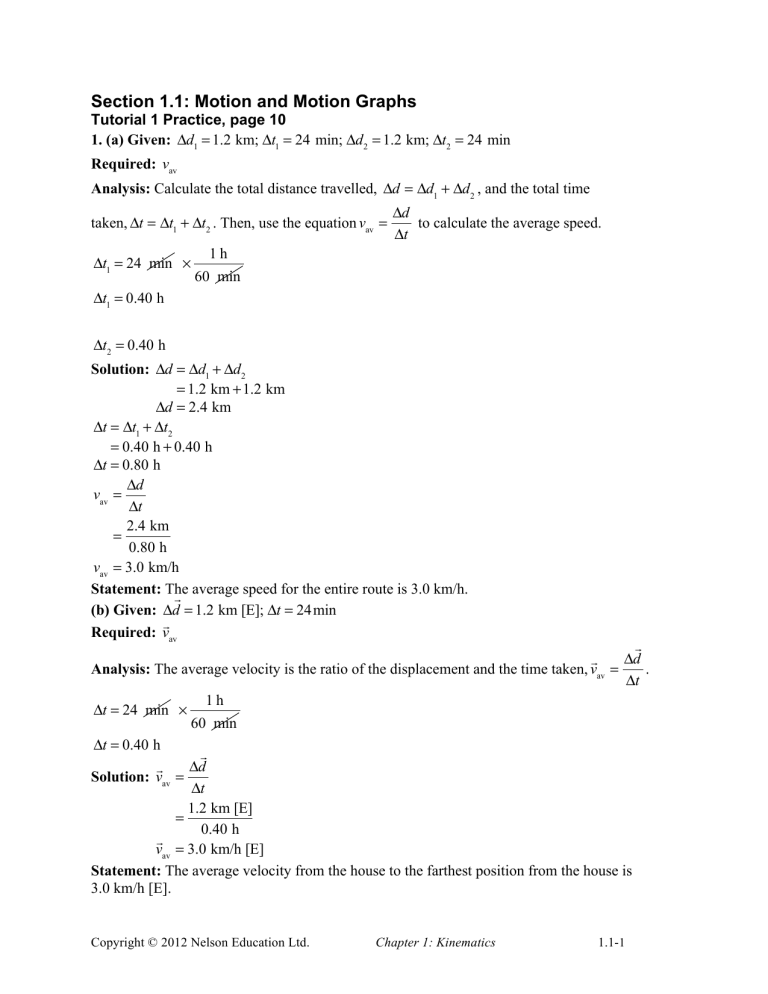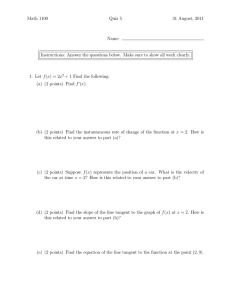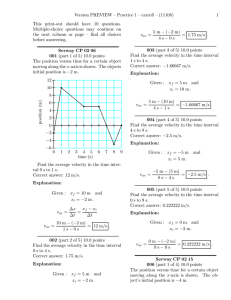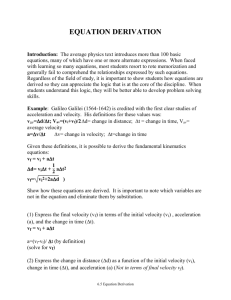
Section 1.1: Motion and Motion Graphs Tutorial 1 Practice, page 10 1. (a) Given: !d1 = 1.2 km; !t1 = 24 min; !d2 = 1.2 km; !t2 = 24 min Required: vav Analysis: Calculate the total distance travelled, !d = !d1 + !d2 , and the total time taken, !t = !t1 + !t2 . Then, use the equation vav = !t1 = 24 min " 1h !d to calculate the average speed. !t 60 min !t1 = 0.40 h !t2 = 0.40 h Solution: !d = !d1 + !d2 = 1.2 km + 1.2 km !d = 2.4 km !t = !t1 + !t2 = 0.40 h + 0.40 h !t = 0.80 h !d vav = !t 2.4 km = 0.80 h vav = 3.0 km/h Statement: The r average speed for the entire route is 3.0 km/h. (b) Given: !d = 1.2 km [E]; !t = 24min ! Required: vav ! !d ! Analysis: The average velocity is the ratio of the displacement and the time taken, vav = . !t 1h !t = 24 min " 60 min !t = 0.40 h ! !d ! Solution: vav = !t 1.2 km [E] = 0.40 h ! vav = 3.0 km/h [E] Statement: The average velocity from the house to the farthest position from the house is 3.0 km/h [E]. Copyright © 2012 Nelson Education Ltd. Chapter 1: Kinematics 1.1-1 r r (c) Given: !d1 = 1.2 km [E]; !t1 = 0.40 h; !d2 = 1.2 km [W]; !t2 = 0.40 h ! Required: vav Analysis: Since the two displacements are equal in magnitude and opposite in direction, the total displacement during the walk is 0.0 km. So, the average velocity is 0.0 km/h. Statement: The average velocity is 0.0 km/h. (d) Answers may vary. Sample answer: The average velocities in parts (b) and (c) are different. Average velocity depends on displacement, which is a vector quantity. Since the displacements are not the same, the average velocities are not the same. ! 2. Given: v = 27 m/s [forward]; !t = 0.32 s ! Required: !d ! r r r !d ! Analysis: Rearrange vav = to solve for !d: !d = vav !t. !t r r Solution: !d = vav !t = (27 m/s [forward])(0.32 s) r !d = 8.6 m [forward] Statement: The bus moves 8.6 m [forward] before the driver reacts. 3. Given: !d = 200 laps, at 4.02 km/lap; !t = 6.69 h Required: vav in km/h Analysis: Calculate the distance covered (in kilometres) and then the average speed, vav = Solution: !d = 200 laps " 4.02 km 1 lap !d = 804 km !d . !t !d !t 804 km = 6.69 h vav = 1.20 " 102 km/h vav = Statement: The average speed of a driver who completes 200 laps in 6.69 h is 1.20 ! 102 km/h . 4. (a) Given: !d1 = 140 m; !t1 = 55 s; !d2 = 45 m; !t2 = 21 s r Required: vav Analysis: Calculate the total distance walked, !d = !d1 + !d2 , and the time taken, !t = !t1 + !t2 . Then, calculate the average speed using vav = Solution: !d = !d1 + !d2 = 140 m + 45 m !d = 185 m !t = !t1 + !t2 = 55 s + 21 s !t = 86 s Statement: The student’s average speed is 2.4 m/s. Copyright © 2012 Nelson Education Ltd. Chapter 1: Kinematics !d . !t !d !t 185 m = 76 s vav = 2.4 m/s vav = 1.1-2 ! ! (b) Given: !d1 = 140 m [E]; !t1 = 55 s; !d2 = 45 m [W]; !t2 = 21 s r Required: vav ! ! ! Analysis: Calculate the total displacement, !d = !d1 + !d2 . Then, calculate the average velocity ! !d ! using vav = . Use east as positive. !t ! ! ! ! !d ! Solution: !d = !d1 + !d2 vav = !t = 140 m + ("45 m) 95 m [E] = = +95 m 76 s ! ! !d = 95 m [E] vav = 1.2 m/s [E] Statement: The student’s average velocity is 1.2 m/s [E]. ! ! 5. (a) Given: !d1 = 62 km [S]; !d2 = 78 m [N]; vav = 55 km/h ! Required: vav !d Analysis: Use the total distance, !d = !d1 + !d2 , and average speed, vav = , to determine the !t ! ! ! time taken for the trip, !t . Then, determine the total displacement, !d = !d1 + !d2 . Then ! !d ! calculate the average velocity using vav = . Use north as positive. !t !d Solution: !d = !d1 + !d2 vav = !t = 62 km + 78 km !d !t = = 140 km vav !d = 140 km 140 km = 55 km /h !t = 2.545 h (two extra digits carried) ! !d ! vav = !t = ("62 km) + (+78 km) 16 km [N] = = +16 km 2.545 h ! ! !d = 16 m [N] vav = 6.3 km/h [N] Statement: The truck’s average velocity is 6.3 km/h [N]. (b) Answers may vary. Sample answer: The truck turned around at one point during its trip. At the end, it was only 16 km away from where it started. As a result, the magnitude of the average velocity is quite low compared to the average speed. ! ! ! !d = !d1 + !d2 Copyright © 2012 Nelson Education Ltd. Chapter 1: Kinematics 1.1-3 Tutorial 2 Practice, page 13 1. (a) Velocity is slope on a position–time graph. Graph (c) has increasing slope, showing that the velocity is increasing. (b) Graph (b) has decreasing slope, showing that the velocity is decreasing. 2. Answers may vary. Sample answers: (a) Initially, the velocity is large and constant in the east direction. Then, it is lower and constant in the east direction. Calculate the slope of each section of the position–time graph using data from the graph. t (s) 0.0 0.2 0.8 ! 0.0 20 30 d (m [E]) ! ! ___ r 30 " 20 !d 20 " 0.0 !d v (m/h [E]) = = 100 = = 17 !t 0.2 " 0.0 !t 0.8 " 0.2 Use these velocity data to draw a velocity–time graph. (b) Initially the velocity is large and constant in a west direction, then it is zero and finally it is low and constant in an east direction. Calculate the slope of each section of the position–time graph using data from the graph. 0.0 0.5 1.0 2.0 t (h) ! 0.0 15 15 0.0 d (m [W]) ! ! ! ___ ! 15 " 15 !d 15 " 0.0 !d !d 0.0 " 15 v (m/h [W]) = = 30 = =0 = = "15 !t 0.5 " 0.0 !t 1.0 " 0.5 !t 2.0 " 1.0 Use these velocity data to draw a velocity–time graph. Copyright © 2012 Nelson Education Ltd. Chapter 1: Kinematics 1.1-4 (c) Initially the velocity is low and constant in a north direction, and then it is large and constant in a south direction. Calculate the slope of each section of the displacement–time graph using data from the graph. 0.0 4.0 8.0 t (h) r 50 100 !50 d (m [S]) ! ! ___ r !d ("50) " 50 !d 100 " ("50) v (m/h [S]) = = "25 = = 37.5 4.0 " 0.0 8.0 " 4.0 !t !t Use these velocity data to draw a velocity–time graph. Tutorial 3 Practice, page 15 1. Answers may vary. Sample answer: (a) The velocity–time graph is a straight line showing that the car’s velocity is changing at a constant rate. So, the car is moving with constant acceleration. (b) The car starts from rest at t = 0 s. It moves north with increasing speed and constant acceleration. The car is moving at 12 m/s after 6.0 s. (c) Given: velocity–time graph ! Required: a Analysis: Read the coordinates of two points on the graph. Use these points to calculate the ! ! !v slope of the line, a = . As in the graph, use north as positive. !t Solution: Two clear points are (0.0 s, 0 m/s) and (6.0 s, 12 m/s). ! ! !v a= !t 12 m/s " 0 m/s = 6.0 s " 0.0 s 12 m/s = 6.0 s = +2.0 m/s 2 ! a = 2.0 m/s 2 [N] Statement: The acceleration of the car is 2.0 m/s2 [N]. Copyright © 2012 Nelson Education Ltd. Chapter 1: Kinematics 1.1-5 2. Answers may vary. Sample answer: (a) Given: velocity–time graph ! Required: aav Analysis: Read the coordinates of the initial and final points on the graph. Use these points to ! !v ! . As in the graph, use forward as positive. calculate the slope of the secant, aav = !t Solution: The points are (0 s, 0 m/s) and (6 s, 35 m/s). ! !v ! aav = !t 35 m/s " 0 m/s = 6 s"0 s = +6 m/s 2 ! aav = 6 m/s 2 [forward] Statement: The average acceleration of the car for the entire trip is 6 m/s2 [forward]. (b) Given: velocity–time graph ! Required: a at t = 3 s and at t = 5 s. Analysis: The instantaneous acceleration at a given time is the slope of the tangent to the velocity–time graph at that time. Sketch tangent lines at the required times, read the coordinates of two points on each tangent line, and then calculate the slopes. Solution: For the tangent at 3 s, two points are For the tangent at 5 s, two points are (1.5 s, 0 m/s) and (6 s, 25 m/s). (2.5 s, 0 m/s) and (6 s, 34 m/s). r r r !v r !v a= a= !t !t 25 m/s " 0 m/s 34 m/s " 0 m/s = = 6 s " 1.5 s 6 s " 2.5 s 25 m/s 34 m/s = = 4.5 s 3.5 s r r 2 a = 6 m/s [forward] a = 10 m/s 2 [forward] Statement: The instantaneous acceleration is 6 m/s2 [forward] at 3 s and 10 m/s2 [forward] at 5 s. (c) The slope of the velocity–time graph increases gradually, so the acceleration–time graph should be increasing. Use the values of instantaneous acceleration from part (b) to draw the graph. Copyright © 2012 Nelson Education Ltd. Chapter 1: Kinematics 1.1-6 3. Answers may vary. Sample answer: (a) Given: velocity–time graph ! Required: aav Analysis: Read the coordinates of initial and final points on the graph. Use these points to !v . As in the graph, use forward as positive. calculate the slope of the secant, aav = !t Solution: The points are (0 s, 50 m/s) and (7 s, 0 m/s). !v aav = !t 0 m/s " 50 m/s = 7 s"0 s "50 m/s = 7s a = "7 m/s 2 Statement: The average acceleration of the car for the entire trip is 7 m/s2 [backward]. (b) Given: velocity–time graph ! Required: a at t = 2 s, t = 4 s, and t = 6 s Analysis: The instantaneous acceleration at a given time is the slope of the tangent to the velocity–time graph at that time. Sketch tangent lines at the required times, read the coordinates of two points on each tangent line, and then calculate the slopes. Solution: For the tangent at 2 s, two points are For the tangent at 4 s, two points are (1 s, 50 m/s) and (3 s, 42 m/s). (3 s, 42 m/s) and (5 s, 26 m/s). ! ! ! !v ! !v a= a= !t !t 42 m/s " 50 m/s 26 m/s " 42 m/s = = 3 s "1 s 5s"3s "8 m/s "16 m/s = = 2s 2s ! ! 2 a = "4 m/s a = "8 m/s 2 For the tangent at 6 s, two points are (5 s, 26 m/s) and (7 s, 2 m/s). ! ! !v a= !t 2 m/s " 26 m/s = 7 s"5 s "24 m/s = 2s ! a = "12 m/s 2 Statement: The instantaneous acceleration is 4 m/s2 [backward] at 2 s, 8 m/s2 [backward] at 4 s, and 12 m/s2 [backward] at 6 s. Copyright © 2012 Nelson Education Ltd. Chapter 1: Kinematics 1.1-7 (c) The slope of the velocity–time graph decreases gradually, so the acceleration–time graph should be decreasing, possibly linearly. Use the values of instantaneous acceleration from part (b) to draw the graph. Section 1.1 Questions, page 16 1. (a) Given: !d1 = 22 m; !d2 = 11 m Required: total distance, !d Analysis: !d = !d1 + !d2 Solution: !d = !d1 + !d2 = 22 m + 11 m !d = 33 m Statement: The total distance travelled by the cardinal is 33 m. (b) Given: !t1 = 2.9 s; !t2 = 1.5 s Required: vav !d . To determine the total time add the partial times, !t = !t1 + !t2 . !t Solution: !t = !t1 + !t2 Analysis: vav = = 2.9 s + 1.5 s !t = 4.4 s !d !t 33 m = 4.4 s vav = 7.5 m/s Statement: The average speed of the cardinal is 7.5 m/s. vav = Copyright © 2012 Nelson Education Ltd. Chapter 1: Kinematics 1.1-8 ! ! (c) Given: !d1 = 22 m [E]; !d2 = 11 m [N] ! Required: vav ! !d ! Analysis: The average velocity is the ratio of the total displacement to the total time, vav = . !t To determine the total displacement, calculate the vector sum of the partial displacements, ! ! ! !d = !d1 + !d2 . Solution: Determine the magnitude of the displacement. ! 2 ! 2 !2 !d = !d1 + !d2 = (22 m)2 + (11 m)2 2 ! = 605 m !d = 24.60 m (two extra digits carried) Determine the angle ! . ! "d2 tan ! = ! "d1 11 m 22 m tan ! = 0.50 = ! = tan #1 (0.50) ! = 27° Determine the average velocity. ! !d ! vav = !t 24.60 m [E 27° N] = 4.4 s ! vav = 5.6 m/s [E 27° N] Statement: The cardinal’s average velocity is 5.6 m/s [E 27° N] . 2. (a) Given: vav = 15.0 km/h Required: vav in m/s Analysis: Convert units using 1 km = 1000 m, and 1 h = 3600 s. km Solution: vav = 15.0 h km 1000 m 1h = 15.0 ! ! 3600 s h 1 km = 4.167 m/s (one extra digit carried) vav = 4.17 m/s Statement: The average speed is 4.17 m/s. Copyright © 2012 Nelson Education Ltd. Chapter 1: Kinematics 1.1-9 (b) Given: !d = 2.90 km; vav = 4.167 m/s Required: !t !d !d Analysis: Use the relation vav = . ; !t = !t vav Solution: !t = = !d vav 2.90 km 1000 m " 4.167 m/s 1 km !t = 696 s Statement: It takes 696 s to complete one lap. 3. (a) Given: !d = 16 m; !t = 2.1 s Required: average speed, vav !d !t !d Solution: vav = !t 16 m = 2.1 s vav = 7.6 m/s Statement: The average speed of the skater is 7.6 m/s. (b) Given: diameter, D = 16 m Required: time for one lap, !t Analysis: vav = Analysis: Calculate the circumference of the pond, !d = " D . Use vav = time, !t , for one lap. Solution: !d = " D = " (16 m) !d = 50.26 m (two extra digits carried) !d to determine the !t !d !t !d !t = vav vav = 50.26 m 7.619 m/s !t = 6.6 s Statement: It takes the skater 6.6 s to go around the edge of the pond. = Copyright © 2012 Nelson Education Ltd. Chapter 1: Kinematics 1.1-10 4. (a) Given: !d = 450 km = 4.5 " 104 m; !t = 45 min Required: vav , in m/s Analysis: vav = !t = 45 min " !d ; !t 60 s 1 min 3 !t = 2.7 " 10 s !d Solution: vav = !t 4.5 " 104 m = 2.7 " 103 s vav = 170 m/s Statement: The airplane’s average speed is 170 m/s. ! (b) Given: !d = 450 km [E 15° N] ! Required: vav , in m/s Analysis: The airplane travels in one direction for the whole trip, so the average velocity is a vector equal in magnitude to the average speed. Solution: The airplane’s average velocity is 170 m/s [E 15° N] . r r 5. Given: vi = 0 m/s; vf = 96 km/h [W]; !t = 4.1 s ! Required: a Analysis: Since the rocket starts from rest, its change in velocity is equal to its final velocity: ! ! !v ! ! . !v = vf . Its acceleration is the ratio of its change in velocity to the time interval taken: a = !t 1h 1 min ! 96 km 1000 m ! ! ! vf = h 60 s 60 min 1 km ! vf = 26.67 m/s [W] (one extra digit carried) ! ! !v Solution: a = !t 26.67 m/s [W] = 4.1 s ! a = 6.5 m/s 2 [W] Statement: The rocket accelerates at 6.5 m/s 2 [W] . Copyright © 2012 Nelson Education Ltd. Chapter 1: Kinematics 1.1-11 ! ! 6. Given: aav = 1.37 ! 103 m/s 2 [W]; "t = 3.12 ! 10#2 s; vf = 0 m/s r Required: velocity of the ball before hitting the wall, vi Analysis: The ball slows down when it hits the wall. Since the acceleration points west, the ! !v ! initial velocity must point east. Use aav = to determine the change in velocity and the initial !t velocity. ! ! !v Solution: a = !t ! ! !v = aav !t = (1.37 " 103 m/s 2 [W])(3.12 " 10#2 s) ! !v = 42.744 m/s [W] (two extra digits carried) r r r !v = vf " vi r r r vi = vf " !v = 0 m/s " 42.744 m/s [W] r vi = 42.7 m/s [E] Statement: The ball hits the wall with velocity 42.7 m/s [E] . ! ! 7. Given: vi = 0 m/s; vf = 9.3 m/s [forward]; !t = 3.9 s ! Required: average acceleration of the runner, aav ! !v ! Analysis: aav = !t ! !v ! Solution: aav = !t 9.3 m/s [forward] " 0 m/s = 3.9 s ! 2 aav = 2.4 m/s [forward] Statement: The runner’s average acceleration is 2.4 m/s2 [forward]. 8. Answers may vary slightly based on student reading of the graph data. Sample answer: (a) Given: position–time graph ! Required: vav for the entire trip Analysis: Read the coordinates of initial and final points on the graph. Use these points to !d calculate the slope of the secant, vav = . As in the graph, use east as positive. !t Solution: The points are (0 s, 0 m) and (14 s, 400 m). Copyright © 2012 Nelson Education Ltd. Chapter 1: Kinematics 1.1-12 !d !t 400 m " 0 m = 14 s " 0 s 400 m = 14 s vav = 29 m/s Statement: The average velocity of the car for the entire trip is 29 m/s2 [E]. (b) Given: position–time graph ! Required: vav from t = 4 s to t = 14 s Analysis: Use the graph to determine the position at t = 4 s and at t = 14 s. Use these points to !d calculate the slope of the secant, vav = . As in the graph, use east as positive. !t Solution: The points are (4 s, 30 m) and (14 s, 400 m). !d vav = !t 400 m " 30 m = 14 s " 4 s 370 m = 10 s vav = 37 m/s Statement: The average velocity of the car for the last 10 s of the trip is 37 m/s [E]. This is higher than for the trip as a whole because the car is accelerating—the car was moving faster on average toward the end of the trip. (c) Given: position–time graph ! Required: v at t = 4.0 s, t = 8.0 s, and at t = 12.0 s Analysis: The instantaneous velocity at a given time is the slope of the tangent to the position– time graph at that time. Sketch in tangent lines at the required times, read the coordinates of two points on each tangent line and then calculate the slopes. Solution: For the tangent at 4.0 s, two points are For the tangent at 8.0 s, two points are (2.0 s, 0.0 m/s) and (6.0 s, 68 m/s). (6.0 s, 70 m/s) and (10 s, 200 m/s). !d !d v= v= !t !t 68 m " 0 m 200 m " 70 m = = 6.0 s " 2.0 s 10.0 s " 6.0 s 68 m 130 m = = 4.0 s 4.0 s v = 17 m/s v = 33 m/s vav = Copyright © 2012 Nelson Education Ltd. Chapter 1: Kinematics 1.1-13 For the tangent at 12 s, two points are (10.0 s, 200 m/s) and (14.0 s, 400 m/s). !d v= !t 400 m " 200 m = 14.0 s " 10.0 s 200 m = 4.0 s v = 50 m/s Statement: The instantaneous velocities are approximately 17 m/s [E] at 4.0 s, 33 m/s [E] at 8.0 s, and 50 m/s [E] at 12.0 s. (d) The slope of the position–time graph gradually increases throughout the trip showing that the velocity is increasing to the east. The velocity–time graph should show this gradual increase; it may be linear. Draw a velocity–time graph using the values of instantaneous velocity. Draw a smooth line for a reasonable trend. 9. Answers may vary slightly based on student reading of the graph data. Sample answer: (a) Given: velocity–time graph ! Required: aav Analysis: Read the coordinates of the initial and final points on the graph. Use these points to !v calculate the slope of the secant, aav = . As in the graph, use forward as positive. !t Solution: The points are (0 s, 50 m/s) and (10 s, 0 m/s). !v aav = !t 0 m/s " 50 m/s = 10 s " 0 s "50 m/s = 10 s aav = "5 m/s 2 Statement: The average acceleration of the car for the entire trip is 5 m/s2 [backward]. Copyright © 2012 Nelson Education Ltd. Chapter 1: Kinematics 1.1-14 (b) Given: velocity–time graph ! Required: a at t = 3 s, t = 6 s and at t = 9 s Analysis: The instantaneous acceleration at a given time is the slope of the tangent to the velocity–time graph at that time. Sketch in tangent lines at the required times, read the coordinates of two points on each tangent line and then calculate the slopes. Solution: For the tangent at 3 s, two points are For the tangent at 6 s, two points are (2 s, 50 m/s) and (4 s, 44 m/s). (5 s, 36 m/s) and (7 s, 24 m/s). ! ! ! !v ! !v a= a= !t !t 44 m/s " 50 m/s 24 m/s " 36 m/s = = 4 s"2 s 7 s"5 s "6 m/s "12 m/s = = 2s 2s ! ! 2 a = "3 m/s a = "6 m/s 2 For the tangent at 9 s, two points are (8 s, 18 m/s) and (10 s, 0 m/s). !v a= !t 0 m/s " 18 m/s = 10 s " 8 s "18 m/s = 2s a = "9 m/s 2 Statement: The instantaneous accelerations are 3 m/s2 [backward] at 3 s, 6 m/s2 [backward] at 6 s, and 9 m/s2 [backward] at 9 s. (c) The slope of the velocity–time graph decreases gradually, so the acceleration–time graph should be decreasing, possibly linearly. Use the values of instantaneous acceleration from part (b) to draw the graph. Copyright © 2012 Nelson Education Ltd. Chapter 1: Kinematics 1.1-15



